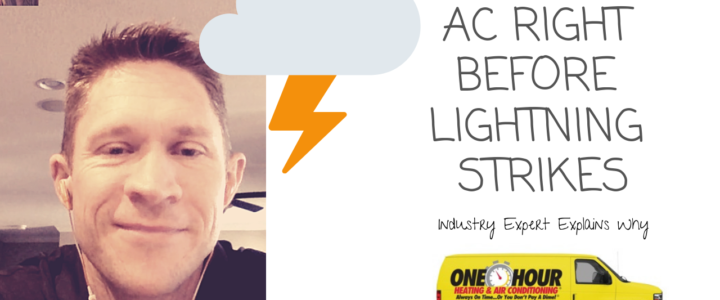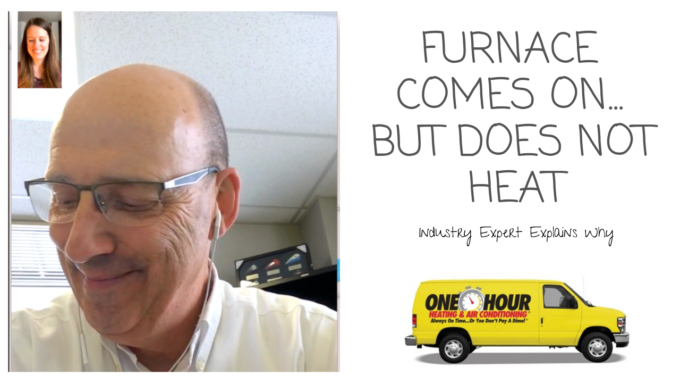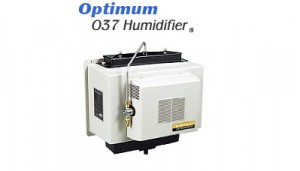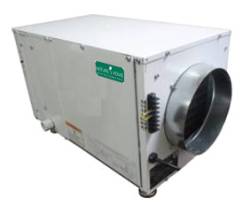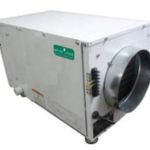How Do Heat Pumps Work?
Before you understand how a heat pump works you must understand how an air conditioner works. A heat pump works just like an air conditioner except it also runs in the opposite direction in order to create heat as well. In heat pump mode we are taking heat out of the air outside moving it inside.
With an air conditioning system, you have the unit outside and a unit inside (usually the furnace down in your basement). The furnace contains the blower which is our means of moving air. You also have a cooling coil located on top of your furnace. Inside of the air conditioner unit outside is a compressor we’ll think of it as a pump that pumps refrigerant between the indoor and outdoor units. Above the outside compressor is a fan.
In the spring and summer when your thermostat says “hey it is getting a little warm in here.” It sends two signals out. It sends one downstairs to the basement and it turns on the blower. The blower now comes on and it starts pulling all the air out of the house via your return air grills. (You see the return air grills usually high on the wall toward an interior wall.) It starts pulling all the air out of the house and it takes it down to the furnace and it then accelerates it and pushes it through that cooling coil.
The cooling coil is hooked up to the unit outside via the refrigerant lines. That the second signal the thermostat sends out is a signal to the unit outside in the yard. This turns on the compressor and it starts starts pumping refrigerant through the coil inside and circulates to the coil outside and back again. It just got this creates this loop of refrigerant going from inside the house to outside the house.
What we’re doing is were actually absorbing the heat out of the house and into the refrigerant. It is being circulated then outside to the coil where we’re circulating it through that coil and we’re releasing the heat outside in the yard. (If you’ve ever placed your hand above the fan on your outdoor unit you feel hot air. That is actually the hot air that was taken out of your house!)
On the inside portion of your cooling system, we’re taking the warm moist air out of the house. Then we’re blowing it through that cooling coil and chilling it making it cooler. Then that cool air gets blown back inside the house.
That’s how an air conditioner works.
A heat pump does that very same thing. Normally you wouldn’t know the difference between an air conditioner or a heat pump. They look exactly the same but unlike your air conditioner, it also starts up in the wintertime. In the winter time we need heat in the house. When you need heat, the thermostat sends out those same two signals. It turns on the blower downstairs and we start gathering all the air up and blowing it through that coil downstairs.
The thermostat also starts up the unit outside and gets the fan going and everything. However, the heat pump is literally running backwards than how an air conditioner works. The refrigerant flow is the opposite of what it is in the air conditioning mode.
In heat pump mode we are taking heat out of the air outside moving it inside.
Then we release the heat from the outside air into your home inside. It is just the opposite of what the air conditioner does.
If it is already cold outside, how are you taking heat out of the air outside and moving it inside in order to heat your home?
Ah you are paying attention. Though it is 32 degrees outside It is outside feels cold to us. There is still usable heat in the air. Absolute zero is way way way below zero. So, on a 30-35 degree day, there’s plenty of heat that we can absorb out of the air outside and release it inside the home.
Pros and Cons of a Heat Pump
Heat pumps do a great job heating your home, however let’s say the temperature overnight gets down to zero. As it gets colder outside, there is less heat available outside. When it is colder outside, the air we are blowing inside will not feel as warm.
At 30-35 degrees there is plenty of heat available outside to heat a typical home. As it gets colder and colder and colder outside at some point the heat pump is going to be running all the time trying to keep up with the demands of what you need inside. Eventually it will need supplemental help. Supplemental help could mean a gas furnace or electric heat strip heat because it is just too cold outside.
The Economics of the Cost of Heating Your Home
For years here in Johnson County, Kansas City Power and Light would have a heat pump rate. There was a dramatic cut in the rate for electricity. In the winter months you would get a drastic cut off your utility rate. And so it was economically advantageous to operate that heat pump instead of burning natural gas. If you think back 10 years ago, natural gas prices were unstable. They would spike up one year, were would see a fifty to a hundred percent increase in gas prices from one year to the next, so it made it very advantageous to use the electric source to heat your home. When you’re using that heat pump you’re using electricity.
Right now we are in 2019. Kansas City Power and Light has taken away those incentives as far as electric rates. (I have a heat pump sitting out in the yard, but I do not use it.) I also have a high efficiency gas furnace and with the price of natural gas and the efficiency of my appliances, I’m better off just using natural gas to heat my home instead of electricity. Without that break in the electrical rate, there is no economic advantage in using the heat pump and personally I find the warmer air from the gas furnace more comfortable.
Now, some climates are perfect for heat pumps no matter the utility rates. There are places in the south were they don’t have weather that goes much below 40 degrees so only having a heat pump is a perfect solution to heating the home.
Also, as far as efficiency goes, with the all electric heat pump, you can think of it as always twice as efficient as that furnace. The furnace air feels warmer, however the heat pump is running twice as efficiently. It will deliver twice as much heat per dollar as the furnace does.
So it just depends on what your options are on weighing the pros and cons of using a heat pump.
How Do You Know if You Have a Heat Pump?
The dead giveaway is on your thermostat. You’ve got a few more switches on your thermostat if you have a heat pump.
With a regular air conditioner thermostat, there are heat | cool | off positions for your system. There may also be a blower switch which either says automatic or on. A heat pump thermostat has few more switches on it. If you have a heat pump you’ll see a term like emergency heat on the thermostat and you’ll have a heat | cool | off switch just like an air conditioner. The emergency heat is a setting that you can manually turn off the heat pump, and turn on the gas furnace or whatever you use for supplemental heat.
If something malfunctions a with the heating option on the heat pump, you can go to manually go to the emergency heat setting turn off the unit outside and still have a source for heat in that house.
What Is That Loud Noise Coming From My Heat Pump?
There are a few common noises that you may have with a heat pump.
Often you may hear a loud shaking from the outdoor unit. That is most often the heat pump going through a defrost mode. Depending on the weather conditions, there will be times when the heat pump has frost form on the unit outside. It is working normally but when the temperature drops outside the heat pump will ask itself every 90 minutes if there is frost on the outdoor unit. It has little sensors so it will know if there is frost or not. If frost is detected it goes through a defrost cycle. That sounds like a “whoosh”. What happens is in order to get rid of the frost the heat pump will reverse the direction of the refrigerant and run backwards. The unit is trying to use the hot gas of the refrigerant to defrost the unit outside.
If you’re fortunate enough to see this defrost mode, it is quite a show. Since it melts the frost off it turns to steam and so it literally looks like their outdoor unit is getting ready to explode.
Seriously, we have gotten terrified calls from homeowners witnessing the defrost mode thinking that something was blowing up outside.
Pro Tip For Being Kind To Your Heat Pump
If you are running your heat pump during winter storms, it is common to hear a rattling noise outside. Ice can form on the fan blades and possibly even get out of balance because there are ice formations on it.
Ice storms is another can be a problematic time for a heat pump. Sometimes it doesn’t hurt to just go ahead and turn it off and run the furnace instead.




